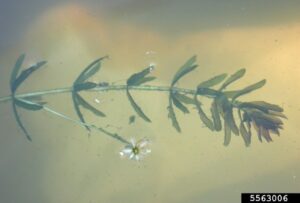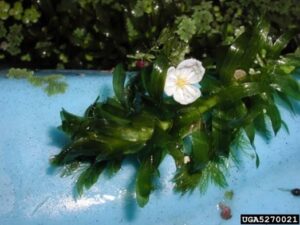Oxygen Weed (Lagarosiphon major)
French common name: elodée africaine, grand lagarosiphon

Oxygen weed underwater
Photo courtesy of Rohan Wells, National Institute of Water and Atmospheric Research, Bugwood.org
Common Names: Oxygen weed, Lagarosiphon, African elodea, curly water weed
Latin Name: Lagarosiphon major
Order: Hydrocharitales
Family: Hydrocharitaceae
Did you know?
Only female oxygen weeds are found outside of the plant’s native range. Thus, this plant is only spread through vegetative propagation which involves a piece of the plant being transported from one area and becoming planted in another location.
Oxygen weed is a perennial aquatic plant originating from South Africa, Zimbabwe, and Botswana. This plant has spread invasively to Europe, the UK, and Australia, but has not yet been detected in the Americas. Oxygen weed can grow to be 3 meters thick in a mat-like spread across an aquatic ecosystem’s floor, with its “J” shaped stem reaching up to 6.5 meters long toward the water’s surface. As an invasive plant, oxygen weed can displace native flora and fauna, in turn reducing biodiversity and decreasing the water quality of an aquatic ecosystem. Historically, oxygen weed has been spread through horticultural practices and for ornamental purposes and is commonly used in the aquaculture and aquarium trade. Oxygen weed poses a threat to Canada’s freshwater systems. To prevent the spread of oxygen weed to Canada, it is important to research ornamental plants for aquarium use, as well as to avoid the spread of aquarium plants to natural areas.
Description
Oxygen weed is known to produce thick mats on the water floor 2 to 3 meters in depth, while stretching up to 6.5 meters long horizontally in a “J” shape toward the surface of the water.

Leaves are green and also “J” shaped, spiraling in an alternative pattern around the stem. They can be 5 to 20mm long and 2 to 3mm wide. Female plants sprout small, purple or pink flowers with 6 petals, growing on long, clear stalks, on the surface of the water. Flowers sprout from summer to early fall.

Similar Plants
Hydrilla (Hydrilla verticillate) | Similar leaves to oxygen weed but are in groups of 4 to 6 and are more sparsely placed along the stem. Similar small flowers on long stalks like oxygen weed but flowers are greenish in colour. | Shaun Winterton, Aquarium and Pond Plants of the World, Edition 3, USDA APHIS PPQ, Bugwood.org |
Dense waterweed (Egeria densa)
| Similar leaves to oxygen weed, but leaves are more densely packed and crowded on the stem, grouped in four or five. The flowers are larger (9-12mm) than oxygen weed’s flowers, are white in colour, and have 3 petals. | Leslie J. Mehrhoff, University of Connecticut, Bugwood.org |
Common elodea (Elodea canadensis) | Similar leaves to oxygen weed, but leaves are grouped in 3. The flowers are white in colour and have 3 petals. | Robert Vidéki, Doronicum Kft., Bugwood.org |
Outside of its native range, oxygen weed only exists as a female plant. Thus, propagation occurs through the dispersal of female plant parts throughout the aquatic ecosystem. This can occur through water currents breaking a fragment of the plant off and bringing it to another spot in the system, where the fragment can become embedded in the substrate and begin growing. Fragments of plants can also be moved and propagated through the passing by of boats, nets, and other aquatic equipment.
Oxygen weed is dormant in winter and emerges in the spring. The female plants’ flowers sprout from summer to early autumn. The growth rate of oxygen weed decreases as sunlight hours per day decrease during the fall.
Oxygen weed grows strictly in aquatic habitats. Its preferred temperature is between 20°C and 23°C, with a maximum of 25°C. Under 10°C, oxygen weed will fail to grow, and an established population will become dormant, meaning it could still survive in cooler Canadian waters. Oxygen weed grows best in still water ecosystems with little water flow and can grow in depths of more than 6 meters deep. Growing in dense mats, oxygen weed will cover other aquatic plants, creating an ecosystem for where other plants find it difficult to grow. Oxygen weed is a hardy plant that can leech nutrients from deep in the soil, meaning it can grow and flourish in otherwise nutrient scarce aquatic ecosystems (Bickel, 2011). However, oxygen weed grows best when high sunlight is accessible, and therefore may not thrive in opaque or highly turbid waters. Given oxygen weed’s hardiness and ability to grow in low nutrient areas, it is able to spread and grow in a variety of water bodies, such as lakes, dams, streams, rivers, and canals which can lead to broader socio-economic impacts.
Due to the growth structure of oxygen weed, an initial sign of infestation may be the dying off of native plants, coupled with the dense growth of the mat-like structure of oxygen weed. Oxygen weed’s growth behaviour and persistence will initially create a less biodiverse ecosystem, which in turn has initial short-term affects on the survivability of native species, such as plants and insects. Amphibian and reptile survival within an aquatic ecosystem also acts as a warning sign that a habitat is decreasing in health. Due to their permeable skin and important roles in the ecosystem, reptile and amphibian survival and health acts as an indicator for the health of their environment, and therefore may indicate an invasive species is taking over an ecosystem.
Oxygen weed has not been documented as established currently in North America. Its native region is in Southern Africa, including Zambia, Zimbabwe, Botswana, Lesotho, and South Africa. Oxygen weed was introduced to New Zealand during the 1950’s as an ornamental aquatic plant. Since, oxygen weed has been found and eradicated in Southern Australia and has also been found in the UK and Europe. Due to the plants’ hardiness and ability to grow under tough conditions, oxygen weed can easily be distributed through accidental transplant of fragments of the plant from place to another. This transplant can be facilitated by water currents and recreational equipment like boats and water waders. Oxygen weed is available from online sellers and distributed to countries where the plant has yet to be introduced. It is assumed that this buying and selling of ornamental plants is how oxygen weed has been distributed internationally.

Ecological Impacts:
Due to oxygen weed’s growth structure, ability to grow quickly under harsh conditions, and ability to distribute, this plant often out-competes native plants for sunlight, space, and access to nutrients. Oxygen weed grows both tall and thick. The roots of oxygen weed form dense mats on the waterbody’s floor, and the tall stems grow to the surface of the water, blocking out sunlight for lower growing plants and space for other plant’s roots to form on the water’s floor. Oxygen weed’s persistence in growth and distribution will decrease the biodiversity of plants in an aquatic ecosystem, which can have long-term effects on the balance of the system’s food web. This decrease in biodiversity fosters an ecosystem with low oxygen and nutrient levels, causing aquatic invertebrates to die off, reptiles, amphibians, and fishes struggle to eat, and mammals and birds who rely on that waterbody strain to find food.
Social and Economic Impacts:
Due to the nature of oxygen weed’s growth, the thickness of its populations impede water recreational uses, such as boating and swimming. This plant can become wrapped around motor blades and can impede fishing, as it creates an uninhabitable ecosystem for fishes to survive. Outside of recreation, oxygen weed has been known to also increase flooding impacts, and can block waterways at hydro-electric dams, causing electrical generation issues.
Oxygen weed is an internationally recognized invasive plant, and many provinces are working to restrict the introduction of this plant. The B.C. Inter-Ministry Invasive Species Working Group considers oxygen weed as a priority species. Although this species is not yet prohibited under the B.C. Wildlife Act, it is still very much under watch. Alberta, Saskatchewan, and Manitoba do not yet recognize oxygen weed as a species of concern, however, the awareness of this species is only growing.
The Government of Ontario has proposed Oxygen weed be considered as a prohibited invasive species under the Invasive Species Act. Prohibited species are illegal to bring into the province, which includes the possession, sale, and propagation of the species within or into the province. This regulation would ensure this highly dangerous invasive plant does not make it into Ontario’s valuable waterways, causing dangerous effects on the ecosystem’s health and economic values. Prevention of species introduction is much easier and cost-effective than controlling a species once it is introduced.
How You Can Help
In the case of species identification, a useful resource for reporting a sighting is EDDMapS (https://www.eddmaps.org/). This user-friendly resource allows community members to report sightings of invasive species that are then confirmed by trained taxonomists who will identify the species via pictures from community members. This resource is accessible to anyone who wants to know what invasive species may be present in their area.
Remember to never let your pets or other at-home species loose! If you own an aquarium or other house plants, make sure you are consulting proper disposal guidelines for water and living plants. DON’T LET IT LOOSE!
Articles and Research
Bickel, T.O. 2011. Lagarosiphon major (Ridley) Moss ex Wager (Curly Water Weed). In: Francis, R.A. (Ed.). A Handbook of Global Freshwater Invasive Species (1st ed.). Routledge.
Schwarz, A. M., & Howard-Williams, C. (1993). Aquatic weed-bed structure and photosynthesis in two New Zealand lakes. Aquatic Botany, 46(3-4), 263-281.
Resources
USDA National Invasive Species Information Centre: https://www.invasivespeciesinfo.gov/aquatic/plants/oxygen-weed
Integrated Taxonomic Information System: https://www.itis.gov/servlet/SingleRpt/SingleRpt?search_topic=TSN&search_value=565981#null
IUCN Global Invasive Species Database: http://www.iucngisd.org/gisd/speciesname/Lagarosiphon+major
Centre for Agriculture and Biosciences International Digital Library: https://www.cabidigitallibrary.org/doi/10.1079/cabicompendium.30548
Weeds of Australia: https://keyserver.lucidcentral.org/weeds/data/media/Html/lagarosiphon_major.htm
Defenders of Wildlife: https://defenders.org/wildlife/amphibians#:~:text=Amphibians%2C%20like%20frogs%2C%20toads%20and,animals%20are%20affected%20by%20them.
Invasive Species Council of British Columbia: https://bcinvasives.ca/wp-content/uploads/2023/06/AIS-Field-Guide-BC-WEB.pdf
Further Reading
U.S. Fish and Wildlife Ecological Risk Screening Summary: https://www.fws.gov/sites/default/files/documents/Ecological-Risk-Screening-Summary-African-Elodea.pdf
Government of Ontario proposed prohibited invasive species: https://www.ontario.ca/page/new-invasive-species-proposed-regulation-under-invasive-species-act#:~:text=Oxygen%20weed%20(aquatic%20plant)&text=the%20United%20Kingdom.-,Not%20known%20to%20occur%20in%20the%20wild%20in%20Ontario.,through%20contaminated%20watercraft%20between%20waterbodies.



